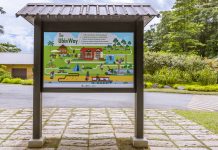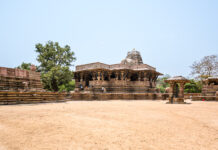
The first-ever Festival of Places (7-9 April 2017) is currently on in Indira Gandhi National Centre for Arts, New Delhi. Incidentally, I was invited to speak here on its inaugural day (7 April). The proposed topic was – ‘A Change in the way We Think, Talk and Use Public Spaces’. This article is a gist of my talk there. It uses Akko Crusader Fortress as an excellent example a deliberately designed repurposing of space.
Akko Crusader Fortress – Designed Repurposing of Space
As a Travel Photographer who aims to make destinations desirable, I look for beauty in a place. Mostly, this beauty is evident. In some cases, I have to unearth it, as it may not be that obvious.
I have travelled to numerous destinations – both, in India and abroad. I have noticed that the destinations sought after by travellers for their heritage and history have their own unique brand of spaces that attract.
Common sense tells me that when these spaces were created, they had a strong purpose that was relevant to the people of those times. Once the times change, many of these structures would lose their relevance.
For example, Baolis (Stepwells) were created as a place that helped harvest rainwater to meet a community’s needs. They also acted as “Facebook/Twitter/Social Media of that era where the community gathered for catching up on news.” – as quoted by Vikramjit Singh Rooprai, a heritage activist and a fellow speaker at ‘Festival of Places’.
Once that happens, a natural progression is these spaces are then re-purposed.
Let us take a look at some such repurposed spaces
Jantar Mantar, New Delhi was built in 1724. It is a set of 13 architectural astronomy structures. Its primary purpose was to track the timing and the movement path of various planets and stars. As times changed, this structure was no longer required to perform its mandated purpose.
Hence, the people in Delhi repurposed this space for various protests, simply because this space was close to the Indian Parliament building.

Similarly, the UNESCO heritage site of Red Fort was built with an original purpose of fortification. Over the years, the task of such fortification became more sophisticated. It meant – defence forces that use myriad ways of securing the nation’s borders hijacked the original purpose of Red Fort.
Result? Red Fort was repurposed as a historically significant space. It started getting thronged by travellers interested in Nation’s glorious history. Additionally, the ramparts of this fort are used for the Independence Day speech of India’s Prime Minister.

Designed Repurposing of Spaces
There is nothing wrong if these spaces get repurposed; particularly, if it happens with a thought. And here, the thought cannot just be to protect a historical monument.
Such superficial reason to protect a heritage structure is unlikely to stop the ravages of times and communities. It is likely that sooner or later, such a structure will bite the dust, as the people of the vicinity would see no plausible benefit.
Here, a case in point is the ancient monuments of Delhi. Vikramjit, on his site www.monumentsofdelhi.com, pegs the total number of such historical monuments at 1317.
While a couple of hundred of these monuments are being looked after by the state government, records of Archeological Survey of India (ASI) show that ASI manages 174 of these.
But this number dwindled to 149 when ASI did a physical verification. It seems that the missing 25 monuments have been demolished and the people of the vicinity have repurposed its building material and location, as they saw no practical use of those old dilapidated structures (Data Source: The Times of India Archives, courtesy Dr Nalin Mehta, a fellow speaker at ‘The Festival of Places’).
Given this reality, it is imperative that if the governments wish to protect such spaces, they should now allow arbitrary or accidental repurposing of such spaces. They actually need to design a complete repurposing package.
Akko (Acre) Crusader Fortress
An excellent example of ‘repurposing with a clear design’ is the Akko Crusader Fortress. The Old Acre Development Company Ltd., a Government Company reporting into the Israel Ministry of Tourism, is managing this fortress. While it was accorded a UNESCO heritage site status in 2001, the excavations to unearth this Pompeii-like township continued. Its newly excavated areas were opened to the public in 2011.
The fortress has used dioramas, still and video projections, and life-sized statues in period costumes to bring the history of the place alive. These efforts help the visitors get a deeper understanding of the history of the crusader era Israel. A day visit to the Fortress costs 40 Shekels (approx. Rs. 800).
But this day visit is just a vanilla version experience of this fortress that has seen the knights jousting in its portals, kings plotting and annihilating enemies, prisoners who were condemned to the underground dungeons, and more.
The Royal Experience
Akko Fortress offers an embellished experience to visitors. Here, you may reserve a seat at the royal dinner table and dine with a make-believe King. This experience begins as soon as you arrive outside the fortress. Just outside the fortress, you are greeted with knights dressed in crusader era costumes, elegantly perched on their handsome steeds.
Once you enter the fortress building, a sommelier offers you a welcome drink of wine. Hostesses dressed in period finery usher you towards the royal dining hall. Along the path, you see the day-to-day happenings from the annals of history – slaves digging a tunnel, a wrongdoer being whipped by a prison guard, etc.
Furthermore, in the royal dining hall, you are made to doff a colourful paper crown and become royalty. As soon as you are seated, a troupe of royal entertainers waltzes in to regale you with their performances during the evening. Soon enough, you see entertainers of all hues – dancers, musicians, acrobats, jesters, fire dancers, and knights. And did I say there is a king too! This 2.5-hour dinner is rounded off with an exhilarating show of jousting!
This surreal experience costs the visitors 200 Shekels (approx.. Rs. 4000)

The Advantages
This dining experience creates longer-lasting memories for the visitor and they get their bragging rights of having dined in a UNESCO heritage site. Naturally, it heightens their engagement with the fortress and helps them develop a better understanding of the history of medieval Israel. And of course, it helps the organisers bag 5x revenue!
For the local community, it brings in more travellers to their city for longer time – leading to more spending by the tourists. It also has generated a lot of direct and indirect employment for the residents in and around Akko. Surely that gets in more overall revenue for this small town. It has also given them a reason to be proud since the gushing travellers rate Akko as a ‘Must-Visit’ site in Northwest Israel.

So, what’s the point?
Nothing stops us in India to create such memorable experiences around these heritage spaces that may have lost their original purpose and relevance, but can still turn into a rich source of revenue for the community around these spaces. Such designed repurposing will truly be a win-win-win for all stakeholders.
Now, can you imagine the pull of a Royal Mughal Dining experience in Taj Mahal precincts or inside the fort walls of Red Fort? Additionally, can you imagine the revenue potential it offers the resource-starved government departments? Such experiences have a potential of enhancing India’s pull as a destination. And the visitors who experience it will not be wrong in flagging our country as ‘Incredible India’!



































